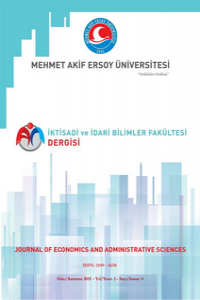PSYCHOLOGICAL HARASSMENT IN THE WORKPLACE WITHIN THE FRAME OF INDIVIDUAL DIFFERENCES AND SOCIAL DISADVANTAGES: MOBBING
Abstract
Working life is along with being a part of one’s routine
life, especially in the societies like us it is the great part of a person and
because of this it shows the qualifications which effects and identifies the person
in a large scale. Thus, person can easily and automatically makes the working
life a part of his private life. At this point, some problems which the person cannot
identify and cannot cope with can arouse. In the context of whether the
person’s special affairs or the habits and the attitude of the society in the
working life, some problems which are not in the inner dynamics of the working
life but can be come across so often draw one’s attention. As these kind of
problems called “mobbing” can be mixed up with other behaviours, a seperate
field of study and discussion is delayed by a historical aspect, but from now
on it manages to enter into the subjects of psychology of working and
organizational sociology.
Keywords
References
- Atalay, Hakan (2011), “İşte Biz O Gün Tükeneceğiz”, Psikeart Dergisi, Sayı. 15, (29-39).
- Baymur, Feriha (1994), Genel Psikoloji, İnkılap Yayınları, İstanbul.
- Boratav, Cumhur (2011), “Nsa Agn”, Psikeart Dergisi, Sayı. 15, (8-19).
- Cüceloğlu, Doğan (1998), İnsan ve Davranışı, Remzi Kitabevi, İstanbul.
- Çokgüler, Aslı (2014), “Onurlu Çalışma Hakkı”, Psikeart Dergisi, Sayı. 36, (6-12).
- Eğrilmez, Ayhan (2011) “Tüketim Toplumunun Tükenen İnsanı”, Psikeart Dergisi, Sayı. 15, (6-7).
- Erkoç, Şahap - Artvinli, Fatih (2011), “Yabancılaşmak mı, Delirmek mi?” Psikeart Dergisi, Sayı 17, (6-11).
- Freud, Sigmund (1995), Uygarlık, Din ve Toplum, Öteki Yayınevi, Ankara.
- Güney, Salih (2008), Davranış Bilimleri, Nobel Yayın Dağıtım, Ankara.
- Keser, Aşkın (2009), Çalışma Psikolojisi, Ekin Basım Yayın Dağıtım, Bursa.
- Kolçak, Menşure (2012), Meslek Etiği, Murathan Yayınevi, Ankara.
- Outhwaite, William (2008), Modern Toplumsal Düşünce Sözlüğü, İletişim Yayınları, İstanbul.
- Poussard Minibaş, Jale - Çamuroğlu İdiğ, Meltem (2009), Psikolojik Taciz, Nobel Yayın Dağıtım, Ankara.
- Şimşek, Şerif - Akgemci, Tahir - Çelik, Adnan (2003), Davranış Bilimlerine Giriş ve Örgütlerde Davranış, Adım Matbaacılık, Konya.
- Tarhan, Nevzat (2010), Toplum Psikolojisi, Timaş Yayınları, İstanbul.
- Tonbul, Gürol (2014), Zorbalık Yaklaşımı ve Artçı Sarsıntılar”, Psikeart Dergisi, Sayı 36, (100 -105).
- Zencirkıran, Mehmet (2015), Sosyoloji, Dora Basım Yayın Dağıtım, Bursa.
Abstract
Çalışma hayatı, kişinin rutin yaşamının bir parçası olmakla birlikte,
özellikle Türkiye gibi toplumlarda büyük bir parçası olmaktan ötürü, bireyi geniş
çaplı bir boyutta etkileyen ve belirleyen nitelikler göstermektedir. Öyle ki birey,
çalışma hayatını hane içi özel hayatının bir parçası olma mertebesine
kolaylıkla ve kendiliğinden getirmektedir. İşte tam bu noktada, bireyin de
anlamlandırmakta güçlük çekebileceği ve baş etmekte zorlanacağı birtakım
sorunlar baş gösterebilir. Gerek bireyin kendi özel durumları gerekse çalışma hayatının
içinde gerçekleştiği toplumun yargıları ve alışkanlıkları bağlamında; meslek hayatının
iç dinamiklerinde yeri olmayan fakat sıkça karşılaşılan çeşitli sorunlar göze
çarpmaktadır. “Mobbing” adı verilen bu sorunların birçok diğer davranış
biçimiyle karıştırıldığı için, ayrı bir çalışma ve tartışma alanı olması tarihsel
açıdan gecikmiş olmakla beraber; artık özellikle çalışma psikolojisi ve örgüt
sosyolojisi alanlarının araştırma kadrajlarına girmeyi başarmıştır.
Keywords
References
- Atalay, Hakan (2011), “İşte Biz O Gün Tükeneceğiz”, Psikeart Dergisi, Sayı. 15, (29-39).
- Baymur, Feriha (1994), Genel Psikoloji, İnkılap Yayınları, İstanbul.
- Boratav, Cumhur (2011), “Nsa Agn”, Psikeart Dergisi, Sayı. 15, (8-19).
- Cüceloğlu, Doğan (1998), İnsan ve Davranışı, Remzi Kitabevi, İstanbul.
- Çokgüler, Aslı (2014), “Onurlu Çalışma Hakkı”, Psikeart Dergisi, Sayı. 36, (6-12).
- Eğrilmez, Ayhan (2011) “Tüketim Toplumunun Tükenen İnsanı”, Psikeart Dergisi, Sayı. 15, (6-7).
- Erkoç, Şahap - Artvinli, Fatih (2011), “Yabancılaşmak mı, Delirmek mi?” Psikeart Dergisi, Sayı 17, (6-11).
- Freud, Sigmund (1995), Uygarlık, Din ve Toplum, Öteki Yayınevi, Ankara.
- Güney, Salih (2008), Davranış Bilimleri, Nobel Yayın Dağıtım, Ankara.
- Keser, Aşkın (2009), Çalışma Psikolojisi, Ekin Basım Yayın Dağıtım, Bursa.
- Kolçak, Menşure (2012), Meslek Etiği, Murathan Yayınevi, Ankara.
- Outhwaite, William (2008), Modern Toplumsal Düşünce Sözlüğü, İletişim Yayınları, İstanbul.
- Poussard Minibaş, Jale - Çamuroğlu İdiğ, Meltem (2009), Psikolojik Taciz, Nobel Yayın Dağıtım, Ankara.
- Şimşek, Şerif - Akgemci, Tahir - Çelik, Adnan (2003), Davranış Bilimlerine Giriş ve Örgütlerde Davranış, Adım Matbaacılık, Konya.
- Tarhan, Nevzat (2010), Toplum Psikolojisi, Timaş Yayınları, İstanbul.
- Tonbul, Gürol (2014), Zorbalık Yaklaşımı ve Artçı Sarsıntılar”, Psikeart Dergisi, Sayı 36, (100 -105).
- Zencirkıran, Mehmet (2015), Sosyoloji, Dora Basım Yayın Dağıtım, Bursa.
Details
| Subjects | Economics, Business Administration |
|---|---|
| Journal Section | Articles |
| Authors | |
| Publication Date | December 30, 2015 |
| Submission Date | November 12, 2016 |
| Published in Issue | Year 2015 Volume: 2 Issue: 2 |

This work is licensed under a Creative Commons Attribution 4.0 International License.
The author(s) bear full responsibility for the ideas and arguments presented in their articles. All scientific and legal accountability concerning the language, style, adherence to scientific ethics, and content of the published work rests solely with the author(s). Neither the journal nor the institution(s) affiliated with the author(s) assume any liability in this regard.


